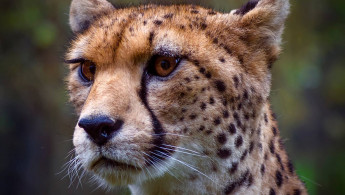WATCH: Ultra-rare Saharan cheetah spotted in Algeria for first time in years
Algerian conservationists sighted the near-extinct big cat in the Ahaggar National Park following a months-long research and imaging project.
2 min read
Saharan cheetahs are thought to number just 200 [Getty]
Algerian conservationists announced on Monday the sighting of the critically endangered Saharan cheetah following months-long research efforts in the Ahaggar National Park in the country's mountainous south.
Thought to number only 200, the rare big cat was spotted by camera traps laid out in the Atakor volcanic field by researchers working on a project run by the national park.
Speaking at an online heritage conference, the Director of the Ahaggar National Park Office Hamoud Amerzagh said that the project had involved fifty researchers across various disciplines, using 40 cameras continuously collecting footage over 120 days, and generating more than 230,000 photos.
The last reported sighting of the cat, also known as the Northwest African cheetah and locally as the amaya, was in 2015 following a similar camera trap project. The footage was later published online.
Since 2016, the Ahaggar National Park has been undertaking various projects to monitor and improve biodiversity and conservation projects in the region.
The sparsely populated species are thought to still inhabit parts of the Central African Republic, Chad, Mali, Benin, Burkina Faso and Niger.
However the big cat is thought to be regionally extinct in many countries where it used to roam, including Morocco, Western Sahara, Senegal, Guinea, Guinea-Bissau, Sierra Leone, Côte d'Ivoire and Ghana.
Little is known about the ultra-rare cheetahs, although similar projects carried out in the Ahaggar park have revealed that the cats have adapted to the harsh desert climate by becoming nocturnal, travelling long distances and existing at lower densities than their savanna-roaming relative.
They are also able to survive without direct access to water, gaining adequate hydration from the blood of their prey.
The wildlife in the Sahara and Sahel is said to have been decimated by the rise in armed conflicts as well as global warming and climate change.
Follow us on Facebook, Twitter and Instagram to stay connected





 Follow the Middle East's top stories in English at The New Arab on Google News
Follow the Middle East's top stories in English at The New Arab on Google News
![Israeli forces ordered bombed Gaza's Jabalia, ordering residents to leave [Getty]](/sites/default/files/styles/image_330x185/public/2176418030.jpeg?h=a5f2f23a&itok=_YGZaP1z)

